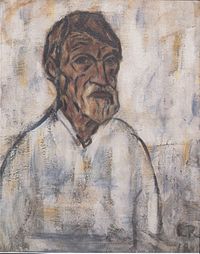Christian Rohlfs
Christian Rohlfs | |
|---|---|
 Christian Rohlfs, self-portrait (1918) | |
| Born | Christian Rohlfs 22 November 1849 |
| Died | 8 January 1938 |
| Nationality | German |
Christian Rohlfs(November 22, 1849 - January 8, 1938) was a German painter and printmaker, one of the important representatives ofGermanexpressionism.
Early life and education[edit]

He was born inGroß Niendorf,Kreis SegeberginPrussia.He took up painting as a teenager while convalescing from an infection[1]that was eventually to lead to the amputation of a leg in 1874.[2]He began his formal artistic education in Berlin,[2]before transferring, in 1870, to the Weimar Academy.[1]
Professional career[edit]
In 1901 Rohlfs left Weimar forHagen,where through the architectHenri van der Veldegot to know the art collectorKarl Ernst Osthauswho offered him a studio in an estate which would become theMuseum Folkwang.[3]Rohlfs was the first artist to begin to work there.[3]Meetings withEdvard MunchandEmil Noldeand the experience of seeing the works ofVincent van Goghinspired him to move towards the expressionist style, in which he would work for the rest of his career.[1]
In 1908, at the age of 60, he made his first prints after seeing an exhibition of works by the expressionist groupDie Brücke.He went on to make 185 in total, almost allwoodcutsorlinocuts.[1]He lived in Munich and the Tyrol in 1910–12, before returning to Hagen.[citation needed].The outbreak ofWorld War Iworried Rohlfs such, that for some time he felt unable to paint.[3]In rare instances he experimented with heavily hand-coloring his prints, onto the verge of painting and sometimes well after they were made, as in his 1919 recoloring of the prior year'sDer Gefangene.[4]
In May 1922 he attended theInternational Congress of Progressive Artistsand signed the "Founding Proclamation of the Union of Progressive International Artists".[5]In 1937 the Nazis expelled him from thePrussian Academy of Arts,condemned his work asdegenerate,and removed his works from public collections.[1]Seventeen of his paintings were exhibited in theDegenerate Art Exhibitionin 1937.[3]He died inHagen,Westfalia,on 8 January 1938.[3]
Style and technique[edit]
Throughout his career he working through a variety of academic, naturalist,impressionist,and Post-Impressionist styles.[6]He has often been viewed as one of the first Expressionists.[3]
Reception[edit]
After his death, the German Nazi authorities prohibited the sale of his paintings.[3]Commemorative exhibitions were organized by theKunstmuseum Baseland theBerner Kunsthalle.[3]
Recognition[edit]
- In 1929 the town of Hagen opened a Christian Rohlfs Museum.[2]
- Honorary citizen ofHagen[3]
- Honorary Doctorate byUniversity of Kiel[3]
- Honorary Doctorate byUniversity of Aachen[3]
Works[edit]
-
Hilly landscape in late autumn, 1900
-
Collegiate Church of St. Patroclus in Soest, 1912,Germanisches Nationalmuseum
-
Landscape vision, 1912,Germanisches Nationalmuseum
-
The temptation of Christ, 1914,Germanisches Nationalmuseum
-
Sternbrücke in Weimar., (ca. 1917)
References[edit]
- ^abcde"Christian Rohlfs (German, 1849–1938)".Museum of Modern Art, New York.Retrieved14 December2013.
- ^abc"Christian Rohlfs".German Art in the 20th Century: Painting and Sculpture 1905 1985(Catalogue of an exhibition held at the Royal Academy of Arts, London). London: Royal Academy of Arts/ Prestel Verlag. 1985. pp. 497–8.
- ^abcdefghijkBarron, Stephanie (1992)."Entartete Kunst": das Schicksal der Avantgarde im Nazi-Deutschland: [eine Ausstellung des] Los Angeles County Museum of Art [übernommen vom] Deutschen Historischen Museum(in German).Hirmer Publishers.pp. 331–332.ISBN3-7774-5880-5.
- ^Cole, William."Christian Rohlfs:Der Gefangene,"Art in Print,Vol. 4 No. 1 (May–June 2014).
- ^van Doesburg, Theo."De Stijl," A Short Review of the Proceedings [of the Congress of International Progressive Artists], Followed by the Statements Made by the Artists' Groups "(1922)".modernistarchitecture.wordpress.com.Ross Lawrence Wolfe.Retrieved30 November2018.
- ^"Christian Rohlfs".www.germanexpressionismleicester.org.2014-09-30.Archivedfrom the original on 2016-03-14.Retrieved2021-12-08.
External links[edit]
- Biography & Works by Christian RohlfsGalerie Ludorff, Düsseldorf, Germany
- Newspaper clippings about Christian Rohlfsin the20th Century Press Archivesof theZBW





